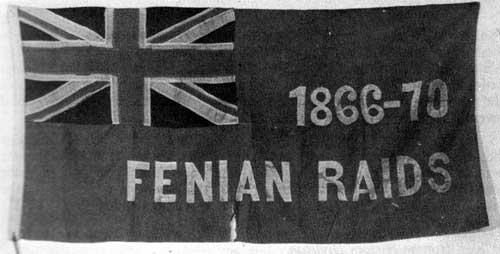by James B. Stanton
Manitoba Pageant, Winter 1972, Volume 17, Number 2
|
In the last few months, the Manitoba Museum has received a number of interesting donations. One of these is the flag shown here, a Red Ensign with the words “Fenian Raids 1866-70” crudely stitched onto it.

Fenian is the name of the old Irish National Militia which adopted the title of Brotherhood in the United States and vowed its intention to liberate Ireland from the English and establish a Republic. Their oath was as follows: “I promise by the divine law of God to do all in my power to obey the laws of the society F.B. and to free and regenerate Ireland from the yoke of England. So help me God.” One of the ways the Fenians proposed to do this was by capturing Canada and using this as a lever to free Ireland.
In the 1860s, Fenians in Canada and the United States had little trouble in gathering many thousands of adherents; in fact, it is said that there were upwards of 350,000 of them. On 4 March 1866 they held a mass meeting in New York and threatened to invade Canada. Fenian activities were not confined to land; on 1 May 1866, the Fenian schooner Friend captured the British schooner Wentworth off Long Island.
During the American Civil War, relationships between Canadians and the Northerners became more strained than ever. The Fenians were quick to take advantage of this. When the Civil War ended, it left in its trail, as wars always do, thousands of ex-soldiers looking for employment and adventure. Many of these men were gladly accepted by the Fenians. After a great deal of talk something had to be done to keep the Fenian “soldiers” from deserting.
Under the leadership of “General” (or was it “Colonel”)? John J. O’Neill the Fenians crossed the border, on 31 May 1866, to conduct a raid on Fort Erie with 600 men. Instead of being welcomed by the Canadians, as saviours from the English oppressors, O’Neill found himself under counter attack from the Canadian militia. The Fenians fled in disorder back to the United States, where, to add insult to injury, many of them were arrested by American authorities for transgressions of the United States Neutrality Law of 1818. President Andrew Johnson proclaimed against them in June of 1866. This, along with their inability to get along with each other, seems to have upset them enough so that they remained relatively quiet until 1870.
O’Neill had been busy planning more invasions and was quietly gathering financial backing and supporters. On 26 May 1870, he again led an unsuccessful raid into Canada and was once more captured upon his return to the United States. This ended the Fenian Raids into Canada.
While the raids themselves now seem to be something out of a comic opera, at the time, Canadians saw them as a real threat. The United States was talking about “manifest destiny” and many Americans felt the “natural” northern border for the United States should be the Arctic Ocean. This would, of course, mean annexation of Canada. Thus, the Fenian actions were instrumental in promoting political union in 1867.
Manitoba did not see any Fenian trouble in either 1866 or 1870 but in 1871, John J. O’Neill made one more attempt to invade Canada. This time, he hoped to enlist the sympathies of the Métis, and was relying on W. B. O’Donoghue, of 1869 uprising fame, for information on the attitudes of the people of Manitoba. Whatever the motives, whether for personal glory, or to free Ireland, their decision to invade Canada with a handful of men must rank high on the scale of crackpot schemes. They captured the trading post at Pembina, itself an object of dispute as to whether it was in Canada or the United States. They were quickly captured themselves by the United States Army. A brief flurry of excitement in Manitoba saw several hundred troops answer the call to arms in a matter of days. Had the Fenians been able to conduct more raids against Manitoba, they would have found themselves meeting considerable resistance.
The Fenian Raids produced a strong sense of national identity among many Canadians and saw the striking of the first distinctively Canadian military medal, known as the Canada General Service Medal (1866-1870). This medal was awarded to members of the Canadian and Imperial forces who took part in the suppression of the Fenian Raids and the Red River Uprising.
Many Canadian militia units were called-up to active duty during the Fenian raids and it is possible that the flag shown here belonged to one of them. The Canadian units involved included the Royal Canadian Rifles, Whittey Rifles, Brockville Rifle Company, Hemmingford Company, Toronto Field Battery, Montreal Garrison Artillery, Montreal and Ottawa Garrison Artillery, Ottawa and Carleton Rifles, Quebec Rifles - and several Canadian Indians who acted as boatmen.
Manitoba saw many flags flying over it, and it is possible that this flag could have been brought out with one of the regiments that came here in 1870. It appears to be of the right age and is the sort of thing regiments often carried with them. It will be featured in a display on the role of the military in the West which will be in the Museum in 1972.
Page revised: 20 July 2009